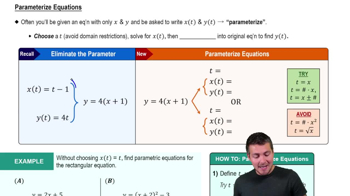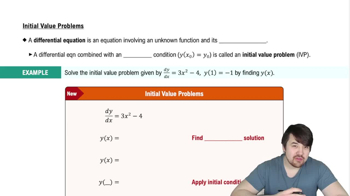Solve the initial value problem for the homogeneous differential equation , with the initial condition . What is the explicit solution ?
Table of contents
- 0. Functions7h 54m
- Introduction to Functions16m
- Piecewise Functions10m
- Properties of Functions9m
- Common Functions1h 8m
- Transformations5m
- Combining Functions27m
- Exponent rules32m
- Exponential Functions28m
- Logarithmic Functions24m
- Properties of Logarithms36m
- Exponential & Logarithmic Equations35m
- Introduction to Trigonometric Functions38m
- Graphs of Trigonometric Functions44m
- Trigonometric Identities47m
- Inverse Trigonometric Functions48m
- 1. Limits and Continuity2h 2m
- 2. Intro to Derivatives1h 33m
- 3. Techniques of Differentiation3h 18m
- 4. Applications of Derivatives2h 38m
- 5. Graphical Applications of Derivatives6h 2m
- 6. Derivatives of Inverse, Exponential, & Logarithmic Functions2h 37m
- 7. Antiderivatives & Indefinite Integrals1h 26m
- 8. Definite Integrals4h 44m
- 9. Graphical Applications of Integrals2h 27m
- 10. Physics Applications of Integrals 3h 16m
- 11. Integrals of Inverse, Exponential, & Logarithmic Functions2h 34m
- 12. Techniques of Integration7h 41m
- 13. Intro to Differential Equations2h 55m
- 14. Sequences & Series5h 36m
- 15. Power Series2h 19m
- 16. Parametric Equations & Polar Coordinates7h 58m
7. Antiderivatives & Indefinite Integrals
Initial Value Problems
Problem 4.9.109d
Textbook Question
107–110. {Use of Tech} Motion with gravity Consider the following descriptions of the vertical motion of an object subject only to the acceleration due to gravity. Begin with the acceleration equation a(t) = v' (t) = -g , where g = 9.8 m/s² .
d. Find the time when the object strikes the ground.
A payload is released at an elevation of 400 m from a hot-air balloon that is rising at a rate of 10 m/s.
 Verified step by step guidance
Verified step by step guidance1
Start by identifying the key components of the problem: the initial height of the payload is 400 m, the initial velocity is 10 m/s (upward), and the acceleration due to gravity is -9.8 m/s² (downward).
Write the position function s(t) for the payload. The general formula for position is s(t) = s₀ + v₀t + (1/2)at², where s₀ is the initial height, v₀ is the initial velocity, and a is the acceleration due to gravity. Substitute s₀ = 400 m, v₀ = 10 m/s, and a = -9.8 m/s².
Set the position function s(t) equal to 0 to find the time when the payload strikes the ground. This represents the moment when the height of the payload is zero.
Solve the quadratic equation obtained in the previous step for t. Use the quadratic formula t = (-b ± √(b² - 4ac)) / 2a, where a, b, and c are the coefficients from the quadratic equation derived from the position function.
Select the positive root of the quadratic equation, as time cannot be negative. This positive root represents the time when the payload strikes the ground.
 Verified video answer for a similar problem:
Verified video answer for a similar problem:This video solution was recommended by our tutors as helpful for the problem above
Video duration:
8mPlay a video:
Was this helpful?
Key Concepts
Here are the essential concepts you must grasp in order to answer the question correctly.
Acceleration due to Gravity
Acceleration due to gravity, denoted as 'g', is the rate at which an object accelerates towards the Earth when in free fall. On Earth, this value is approximately 9.8 m/s². This constant is crucial for understanding the motion of objects under the influence of gravity, as it determines how quickly their velocity changes over time.
Recommended video:

Derivatives Applied To Acceleration Example 2
Kinematic Equations
Kinematic equations describe the motion of objects under constant acceleration. They relate displacement, initial velocity, final velocity, acceleration, and time. In this context, these equations can be used to calculate the time it takes for the payload to hit the ground after being released from the balloon, considering its initial height and the effects of gravity.
Recommended video:
Guided course

Parameterizing Equations
Initial Conditions
Initial conditions refer to the starting parameters of a motion problem, such as initial height, initial velocity, and time. In this scenario, the payload is released from a height of 400 m with an initial upward velocity of 10 m/s. These conditions are essential for accurately applying kinematic equations to determine the time of impact with the ground.
Recommended video:

Initial Value Problems

 5:03m
5:03mWatch next
Master Initial Value Problems with a bite sized video explanation from Patrick
Start learningRelated Videos
Related Practice
Multiple Choice
43
views
